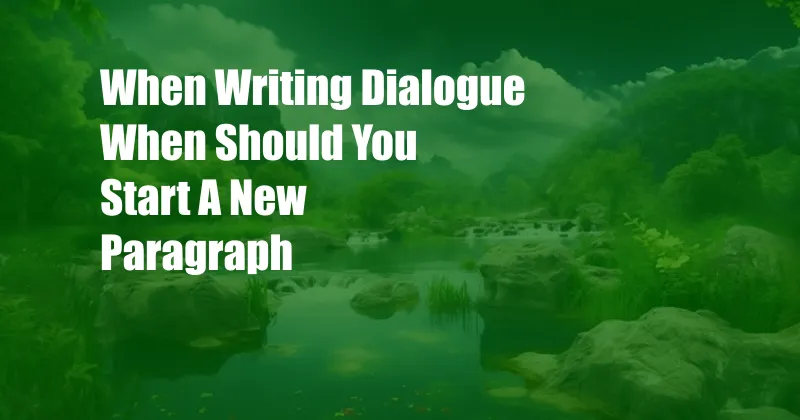
When to Start a New Paragraph in Dialogue: A Comprehensive Guide
As writers, we spend countless hours crafting dialogue that brings our characters to life. However, the subtle art of when to start a new paragraph in dialogue is often overlooked. It’s not merely a matter of aesthetics but rather a crucial element that influences the flow, clarity, and impact of the conversation.
The Rule of Thumb
Generally, a new paragraph should begin whenever the speaker changes or when there is a significant shift in time, location, or topic. By adhering to this rule, we ensure that the dialogue remains organized, easy to follow, and visually appealing.
Paragraph Breaks for Speaker Changes
When two or more characters engage in a conversation, each speaker should occupy a separate paragraph. This allows the reader to effortlessly differentiate between their voices, giving each character a distinct space within the narrative. For instance:
"I can't believe we're actually here," said Sarah, her eyes wide with wonder. "This place is incredible."
"I know," replied John. "It's like something out of a dream."Paragraph Breaks for Time, Location, or Topic Shifts
Dialogue may also transition to a new paragraph when there is a break in the conversation, such as a time lapse, a change in location, or a shift in topic. These transitions help maintain the coherence of the narrative and guide the reader through the ebb and flow of the conversation. For example:
Hours later, the sun had set, casting a warm glow over the city.
"It's getting late," said Mary. "We should head back."
"I agree," said Tom. "Let's go."Other Considerations for Paragraph Breaks
While the rule of thumb provides a solid foundation, there are additional factors to consider when deciding where to start a new paragraph in dialogue. These include:
- Emphasis: A new paragraph can be used to emphasize a particular line or moment in the conversation.
- Suspense: A paragraph break can create suspense by leaving the reader hanging at the end of a thought.
- Visual Impact: The use of shorter or longer paragraphs can influence the pacing and visual appeal of the dialogue.
Expert Tips and Advice on Dialogue Paragraphing
To help writers master the art of dialogue paragraphing, I’ve compiled insights from seasoned authors and editors:
- Use short paragraphs for fast-paced dialogue.
- Break up long paragraphs if they become dense or difficult to read.
- Experiment with different paragraph lengths to create variety and rhythm.
- Avoid starting new paragraphs with dialogue tags.
- Use paragraph breaks to control the flow and pacing of the conversation.
General FAQ on Dialogue Paragraphing
Q: When should I always start a new paragraph in dialogue?
A: Whenever the speaker changes or when there is a significant shift in time, location, or topic.
Q: Can I start a new paragraph with a dialogue tag?
A: Generally, it’s best to avoid starting a new paragraph with a dialogue tag.
Q: How can I use paragraph breaks to enhance the impact of dialogue?
A: Use paragraph breaks to emphasize important lines, create suspense, or control the pacing of the conversation.
Conclusion
Mastering the art of paragraphing dialogue is essential for creating clear, engaging, and immersive narratives. By following the guidelines and expert advice provided in this article, you can elevate your dialogue to new heights, bringing your characters to life in a way that leaves a lasting impression on your readers.
So, are you ready to take your dialogue writing to the next level? Embrace these techniques and embark on a literary journey that captivates your audience from the very first word.